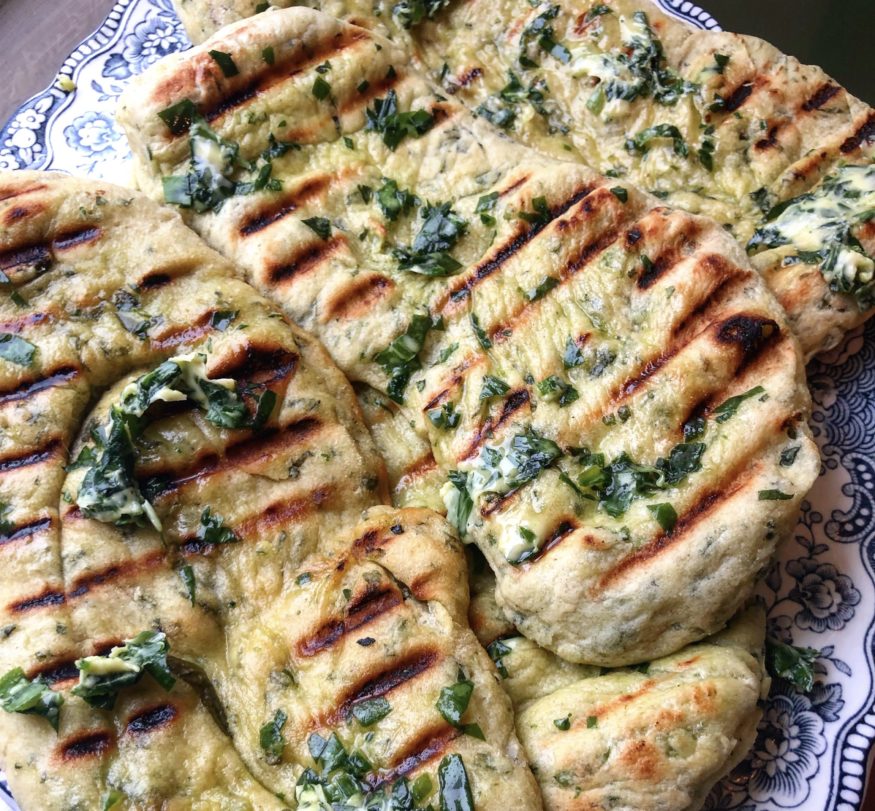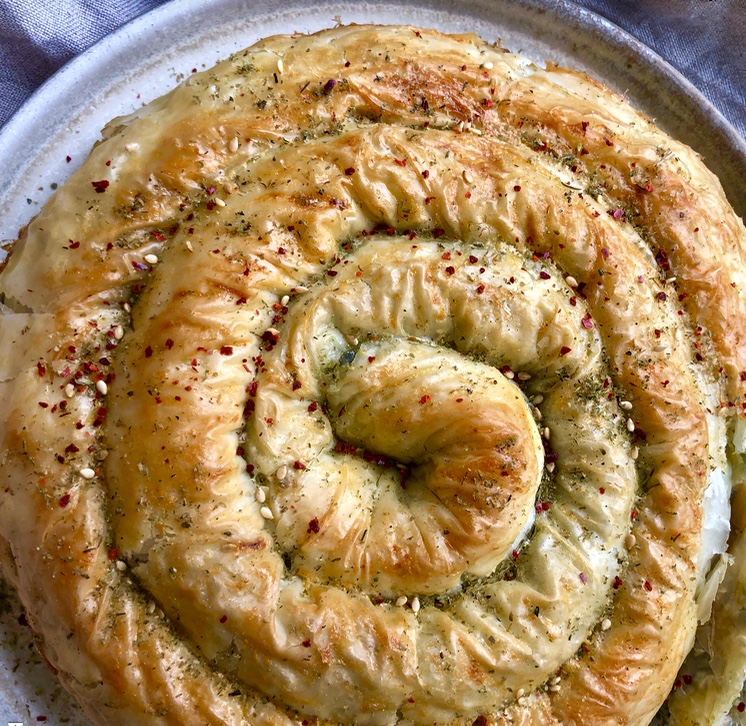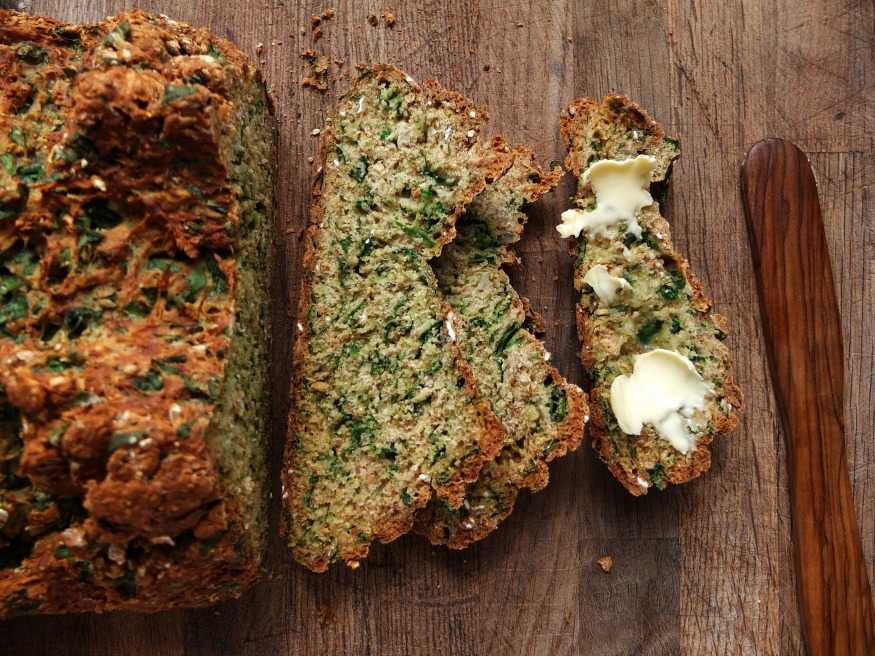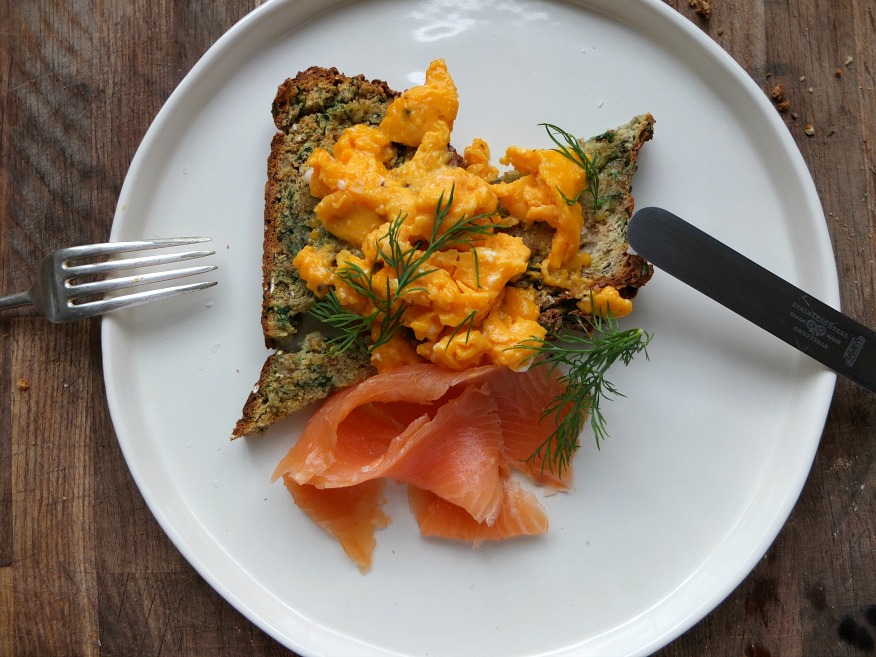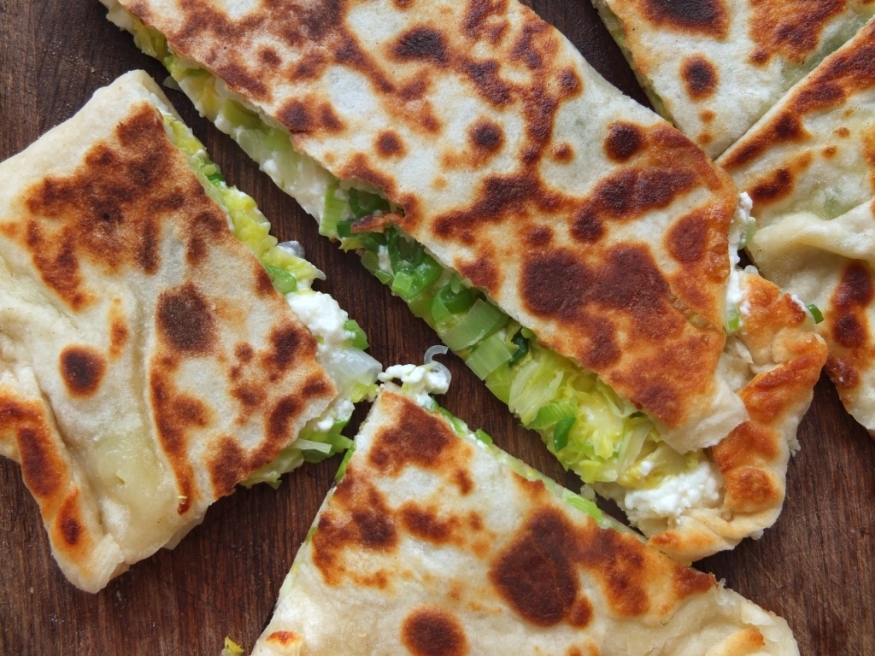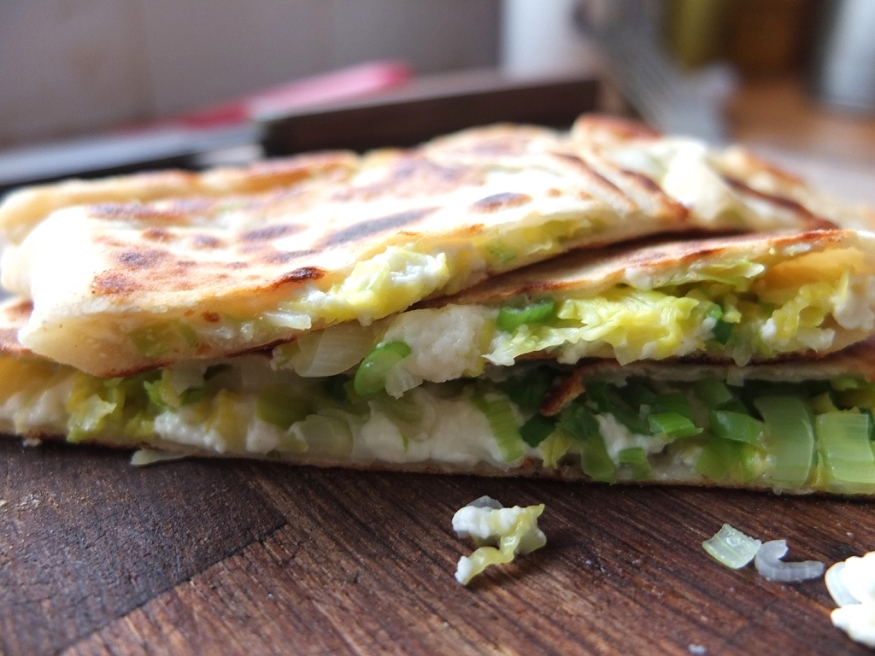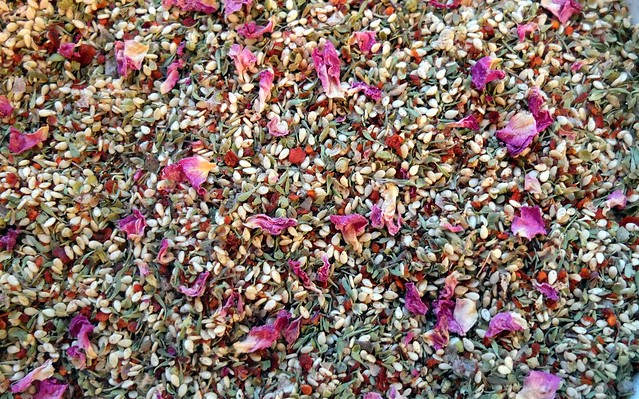If you’re not intrigued by the title ‘mummified cockerel’ then we’re not going to get along, basically. First up, did you even realise cockerels were for eating? Me neither. I thought they were just for strutting about and waking people up with what is, frankly, one of the funniest animal noises ever. When I used to spend a lot of time out in the sticks, the noise of a cockerel never failed to make me giggle, even at 5am; they just sound so ridiculous and desperate.
I spent 15 minutes laughing at videos of cockerels crowing on youtube while writing this post, and that’s before I’d even started referring to the cockerel I cooked as ‘the cock’. So many jokes… ‘I cooked a cock today’. ‘I’m just mummifying a cock’. ‘Anyone for some hot cock?’ (sorry mum).
Enough.

So the Ginger Pig have started doing er, chickens. They’ve started selling these hulking beasts that are a cross between a Cornish game cockerel and a Sussex or Dorking hen. They’re 100 days old (as opposed to 65 for the average commercially grown free range British chicken), they’re dry plucked and then hung for a week to bring out the flavour. That’s a special bird. A special cock. You’re not going to find cock of that quality elsewhere (snigger). They’re massive too, with obscenely plump legs. I’ve always been a thigh woman…
I was sent a cock in the post (giggle), to play around with (smirk), along with some advice to cook it ‘low and slow’. This would ideally happen with some liquid; in a casserole or pot roast for example. Problem is, I didn’t want to do that. I wanted to do something silly like smearing the cock with a kick ass spice paste, wrapping it in flatbreads and cooking it for four hours. So I did. And it worked. Ha! I do this all the time with regular chickens by the way, it’s a Middle Eastern recipe I found in one of my favourite cook books – A Tale of Twelve Kitchens by Peckham based artist Jake Tilson.

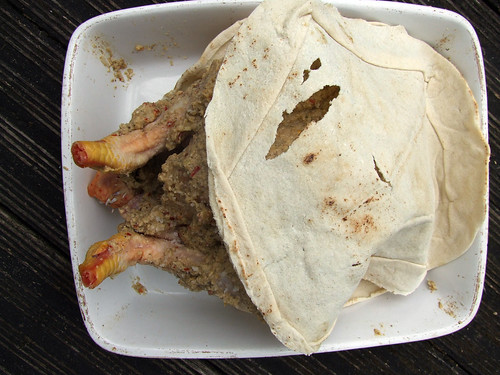
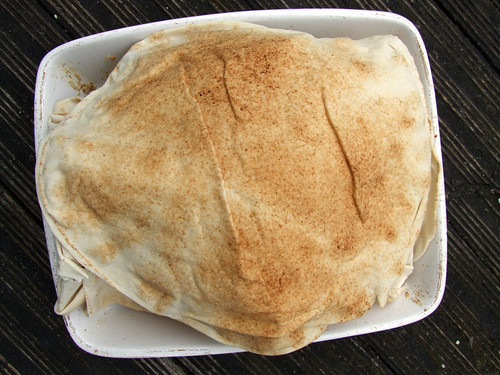
So you sacrifice the crisp skin with this recipe, let’s face up to that right now, but what you get instead is meat of super succulence and a load of bread that has spent 4 hours soaking up chicken fat, juice and spice and let me tell you, it’s off the hook. I witnessed an actual fight over the last piece of that bread between two people that have been friends for quite some years. Be warned.
I made the spice paste by slinging the following into a blender: two onions, 3 cloves of garlic, 2 tablespoons za’atar (a mixture of thyme, sumac, sesame seeds and salt), hot chilli flakes and a splash of oil. I then slapped it all over that cock. Intense. After the slapping part it’s the wrapping part, which is pretty much a case of doing your best to get it all enclosed. I always use a packet of khobez from Persepolis in Peckham (3 or 4 to a pack), which split apart nicely and are the perfect thickness. It’s widely available in London but if you can’t get it I suggest you just do your best with whatever you can find. Don’t use anything too thin like lavash however, as it will crisp up too much and burn.
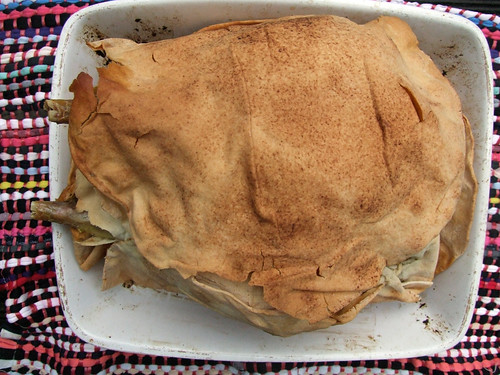
So what of the cooked cock? Well, I was worried about it to be honest; the drawback of this cooking method is that it’s impossible to check on the progress of it once wrapped. I cook a regular chicken this way for 3 hours at 175 degrees. This seems like an age of course but the bird stays very juicy due to the wrapping. I’ve no idea why it’s cooked for so long but that’s what Jake told me to do so I don’t argue. As I’d been warned the cock would take even longer to cook, I gave it 4 hours to be on the safe side which was probably totally unnecessary (although it did no harm). As a friend advised me at the time of cooking, ‘I’d say 4 hours at 175 degrees would cook fucking anything to be honest.’ Well, quite.

This dish is all about the big reveal. Wang it in the middle of the table and crack the crust to release the fragrant spicy meat puff. Ooooh! Aaaaaaah! Once the steam dissipates, the cock is revealed; the drama of de-mummification. At first I was a little taken aback by the funk of the bird; it smelled a little more high than the average chook. In the mouth though, that translated to chicken flavour to the power of 100 days + hanging for 1 week. It’s aged for a reason…
I served my bird on Persian style rice; basmati steamed with cardamom and streaked with steeped saffron. The shredded meat was dabbed with bits of the spice paste and then, then, scattered with what is possibly the best garnish ever: chopped dates fried in butter. They’re really high in calories, what with all that natural sugar and the liberal addition of saturated fat, which is why they taste incredible. If you’re not into the savoury/fruit thing which I know weirds people out sometimes, try them as a topping for ice cream. I wouldn’t want anyone to miss out.
Okay so it’s not the prettiest of dishes but it tastes incredible, it’s fun and it’s always possible to panic garnish with out of season pomegranate seeds, to give it some colour and make it look better in a photo…a little tip for you there. Damn, I could charge for this shit.

The cockerels are available to buy from Ginger Pig now. They cost £8.50/kg, which isn’t cheap by any stretch, but is only a couple of quid more than a standard free range bird and they’re pretty unique. A 3kg bird will feed about 6 people, or greedy me for 3 days.
See here for Ginger Pig branch locations.
Mummified Cockerel
1 x 2.75 kg (or similar sized) cockerel
2 average sized onions
3 cloves garlic
Hot chilli flakes (about a generous tablespoon I suppose)
3 tablespoons za’atar
Salt
A splash of oil
3-4 khobez flat breads (or similar), for wrapping
Preheat the oven to 175c.
Whack the onions, garlic, chilli flakes, za’atar, oil and some salt in a blender. Blend it. Smear it all over the cockerel, inside and out, but mostly out. Split one of the flatbreads so that it is still joined on side; you basically want to tuck the chicken into a bready pocket. Do that. Then keep doing it until you’ve mummified the cock. Just do your best to make sure it’s all wrapped up.
Wrap it loosely in foil and put it in the oven. Cook for 4 hours. Every 45 minutes or so take it out and brush the top of the flatbread liberally with water; this should stop it from burning. You won’t be eating the top bit anyway but burnt stuff doesn’t taste good so don’t skip this bit.
After 4 hours it should be ready; who knows, it might even be ready after 3. Anyway, crack the flatbread crust and get stuck in.
Rice Iranian Stylee (these are Sally Butcher’s quantities from Veggiestan, which means they cater for Iranian – meaning large – appetites. This is also her method for cooking rice, which never fails)
600g rice
800ml water
Generous knob of butter
Pinch saffron strands steeped in a little boiling water
1/2 teaspoon ground cardamom
Pinch ground cinnamon
A few dates, chopped
More butter for frying the dates
Wash the rice well. Put the water and butter in a pan with some salt and bring it to the boil. Add the rice and let it come back to the boil, then turn the heat down really low. Tie a clean tea towel around the lid of the pan, then put it on and let it simmer very gently for 20 minutes. After this time, lift the lid, stir in the cardamom and cinnamon, put the lid back on and steam for another 10 minutes.
Melt some butter in a pan and fry the dates in it for a few minutes.
Streak the saffron through the rice and serve with the chicken and dates on top.
